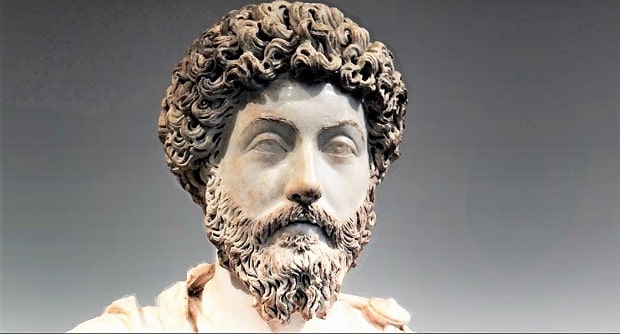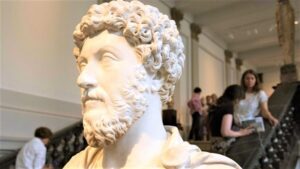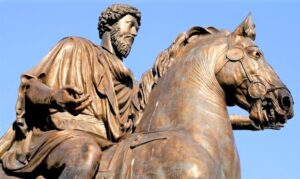
Marcus Aurelius also is known as Marcus Aurelius Antoninus Augustus (Born on April 26, 121, in Rome – Died On March 17, 180, in Vindobona or Sirmio) was emperor of the Roman Empire from the year 161 to the year his death in 180.
He was the last of the so-called Five Good Emperors, third of the emperors of Hispanic origin, and is considered one of the most representative figures of philosophy stoic. Marco Aurelio and Lucio Vero were adoptive children of Antoninus Pius by the mandate of Adriano and the first two that prevailed jointly in the history of Rome.
His government was marked by military conflicts in Asia against a revitalized Parthian Empire and Upper Germania against the barbarian tribes settled along the Limes Germanicus, in Gaul, and along the Danube. During the period of his empire, he had to face a revolt in the eastern provinces led by Avidius Cassius, which he crushed.
Marcus Aurelius’ great work, Meditations, written in Hellenistic Greek during the campaigns of the 170s, is still regarded as a monument to perfect government. It is usually described as “a work written exquisitely and with infinite tenderness.”
Quick Facts: Marcus Aurelius
- Born: 26 April 121, in Rome
- Also Known As: Marcus Aurelius Antoninus Augustus
- Known For: Stoic philosopher and The Emperor of the Roman Empire
- Reign: 8 March 161 – 17 March 180
- Predecessor: Antoninus Pius
- Successor: Commodus
- Co-emperor: Lucius Verus (161–169), Commodus (177–180)
- Parents: Father – Marcus Annius Verus, Antoninus Pius (adoptive). Mother – Domitia Lucilla Minor
- Dynasty: Nerva-Antonine
- Spouse: Faustina the Younger (m. 145)
- Children: Commodus, Lucilla, Marcus Annius Verus Caesar, Vibia Aurelia Sabina, Titus Aelius Aurelius, Fadilla, Gemellus Lucilla, Titus Aelius Antoninus, Hadrianus, Annia Galeria Aurelia Faustina, Annia Cornificia Faustina Minor, Titus Aurelius Fulvus Antoninus, Domitia Faustina.
- Died: 17 March 180 (aged 58), Vindobona or Sirmium
- Burial: Hadrian’s Mausoleum
Early Life of Marcus Aurelius
Marcus Aurelius was born on April 26, 121 AD, to Marcus Annius Verus III and Domitia Lucilla. His name at birth may have also been Marcus Annius Verus just like his father, grandfather, and great-grandfather but, to avoid confusion, we’ll just call him Marcus Aurelius from the start.
His family was wealthy and relatively influential. According to Cassius Dio, one of our main sources for the reign of Marcus Aurelius, his family was somehow related to Emperor Hadrian. Aurelius’s father was a politician who held the office of praetor, but he died young when Marcus was just a child.

We’re not sure on the exact date, but it would have been around 124 AD while he was still in office. After his father’s death, Marcus Aurelius and his sister, Annia Cornificia Faustina, were adopted by their paternal grandfather, Marcus Annius Verus II, who had been made patrician during the reign of Vespasian.
His father had been a praetor and his grandfather served three times as consul so, naturally, it was expected for Marcus Aurelius to follow in their footsteps. In 127 AD, when he was just six years old, he was enrolled in the equestrian order by the nomination of Emperor Hadrian himself.
Other than that, we do not have much information about the early years of the future emperor, apart from the names of some of his teachers such as Diognetus and Alexander of Cotiaeum. Later on, he was also tutored by Apollonius of Chalcedon, the man who introduced him to Stoicism, the philosophy that deeply influenced all aspects of his life.
Rise to Power
Marcus Aurelius was born during the reign of Hadrian, who had no children of his own. Therefore, when the emperor fell ill in 136 AD, he thought it would be a good idea to appoint an heir. He adopted Lucius Ceionius Commodus who, as emperor-in-waiting, took the name Lucius Aelius.
However, this turned out to be an ill-fated choice, as Aelius died at the start of 138 AD. Next up, Hadrian adopted Antoninus Pius as his heir, who became emperor later that same year after Hadrian died on July 10. As it happened, Antoninus was also Marcus Aurelius’s uncle as he married Faustina, his father’s sister.
Hadrian’s adoption of Antoninus came with a few conditions. In turn, Antoninus had to adopt the surviving son of his predecessor, a seven-year-old boy also named Lucius Ceionius Commodus, as well as his own nephew, Marcus Aurelius. All of a sudden, Aurelius was the eldest son of the emperor, which meant that he was next in line for the throne.
Some historians have speculated that this had been Hadrian’s intention all along, although why the emperor granted so much favor to Aurelius, we’re not really sure. Anyway, Antoninus was now the new Roman Emperor and, to strengthen the bond with his newly adopted son, he also had Marcus Aurelius marry his natural-born daughter, Faustina the Younger.
The two of them would go on to have 13 children together. Unsurprisingly, Marcus Aurelius’s position as heir apparent brought with it a lot of new promotions. He was first made consul in 140. He also became the head of the equestrian order, he joined the colleges of priests, he took up residence in the imperial palace and was made quaestor learn about the paperwork and oration that were needed to rule Rome.
Marcus Aurelius Emperor of Rome
Around 160 AD, Antoninus fell ill. He died the following year at his ancestral home in Laurium, ending what was then the second-longest reign of the Roman Empire after that of Augustus. A few days later, he was deified at the request of his sons.
In his book, Marcus Aurelius spoke very fondly of his adoptive father, saying that no other man had more influence on him as a youth. “The king is dead, long live the king,” as the expression goes. Antoninus was gone and Rome needed an emperor.
The Senate was ready to confirm Marcus Aurelius as the new sovereign, but something curious happened. Marcus Aurelius refused to take office unless his younger brother, Lucius Verus, was made co-emperor alongside him. It was unusual, but the Senate accepted and March 8, 161 AD, marked the first time that the Roman Empire was ruled by two men.

That being said, it was never in question who the true leader of Rome was. Besides the fact that Marcus Aurelius was the chosen heir, he was also the older sibling, he had experience helping Antoninus run the empire, and he was the only one with the title of Pontifex Maximus. Verus obeyed Marcus “as a lieutenant obeys a proconsul.”
You might think this is a setup for some kind of conspiracy, or betrayal, or even assassination down the line. That’s usually how these situations unfolded in ancient times, but we have here a rare exception. Despite their different personalities, the brothers stayed on good terms for the extent of their joint rule, and never did one of them try to usurp the other.
The War in Parthia
You might think that the rule of a calm, practical, and amiable man would mark a time of peace for the Roman Empire, but that was not to be. In fact, almost for his entire 19-year reign, Marcus Aurelius was involved in one conflict or another.
First up was the Parthian Empire, a mighty Middle Eastern faction that had been around since the 3rd century BC. This was not the first time that these two powers clashed. It seemed that every time the Parthians wanted to expand to the west, they eventually ran into the dominion of Rome.
This usually took the form of the Kingdom of Armenia, a land that acted as a buffer between the two empires who both wanted to install an Armenian king who served their best interests. The last time this happened was during the rule of Trajan.
That happened almost 50 years before Marcus Aurelius became emperor and, in the end, Armenia became a client state of Rome with its king firmly under Roman control. It seems that every few decades, a new Parthian king gets the same idea – to remove Armenia from under Roman influence and place it under the Parthian influence.
In this case, it was King Vologases IV. In 161 AD, he marched into Armenia and deposed King Sohaemo, replacing him with his own son, Pacorus. The Romans were clearly taken by surprise by this move and their initial reply was disastrous.
Two Roman provinces bordered the Kingdom of Armenia: Cappadocia and Syria. Marcus Sedatius Severianus, the Governor of Cappadocia, decided to take matters into his own hands, even though he was not supposed to act without instructions from the emperor.
Allegedly, an oracle convinced him that he would overpower the Parthians so he took a legion and marched into Armenia. He reached Elegeia where his entire army was surrounded and massacred. As for Severianus himself, he was either killed along with his soldiers or he committed suicide once he realized how badly he had been defeated.
Seizing the upper hand, the Parthians then invaded Syria and bested the Romans there, as well. The first wave of the war went decidedly in the Parthians’ favor and it didn’t look like things were going to get better for the Romans. They were led by two emperors who were completely inexperienced in military matters.
They also had threats to deal with in other frontier provinces such as Britain and Germania Superior. Moreover, the defeat and subsequent retreat of the Roman forces in Syria created perfect conditions for a rebellion. Eventually, Marcus Aurelius decided that Lucius Verus should go in person to guide the war against Parthia.
If anyone was expecting Verus to be a great, inspiring commander, this was the moment that did away with that notion. As it turned out, Verus was the type of leader who preferred to pursue earthly delights and let others do the fighting for him.
Allegedly, he spent most of the Parthian campaign at a resort in Antioch where he feasted and gambled daily, surrounded by his entourage. As it said in the Historia Augusta: “…while legions were being slaughtered, while Syria mediated revolt and the East was being devastated, Verus was hunting in Apulia, traveling about through Athens and Corinth accompanied by orchestras and singers.”
At this time, we should also point out that the veracity of the Historia Augusta is highly uncertain so don’t take anything from it as absolute truth. For his part, Cassius Dio confirmed that Verus made his headquarters in Antioch and didn’t personally take part in any battles, but made no mention of his party lifestyle.
Whatever the truth, fortunately for Rome, there were also a few capable generals who left with Verus and continued on their way to Parthia. Some of the more important ones were Martius Verus, Statius Priscus, and Avidius Cassius. Remember that last one as he will be important later. Martius Verus attacked Armenia and conquered the capital of Artaxata.
He then restored Sohaemus to the throne, the previous king who was subservient to Rome and assumed the governorship of Cappadocia. Historian Cassius Dio gives most of the credit for the eventual Roman victory to Avidius Cassius.
After King Vologases retreated to Parthia, he gave chase, and in 166 AD they sacked the cities of Seleucia and Ctesiphon, the latter being the Parthian capital. Afterward, Avidius made his way to Syria where he eliminated any threat of a rebellion and was installed as the new governor of the province.
Later, Marcus Aurelius would grant him control over all the Roman territories in Asia, a decision he would come to regret.
Antonine Plague
Despite just winning a war, things soon went from bad to worse for the Roman Empire. The soldiers returning home did not come alone. They brought with them a mysterious illness that started one of the first known pandemics in history.
It became known as the Antonine Plague, also known as the Plague of Galen, named after the Greek physician who described the disease and its symptoms in his treatise Methodus Medendi. It caused fever, vomiting, swollen throat, diarrhea, thirstiness, and violent coughing fits that produced a foul odor and skin rashes all over the body.
The illness lasted for about two weeks and the ones fortunate enough to survive it became immune from further infection. The exact nature of the disease is still somewhat of a mystery. Smallpox and measles were generally regarded as the most likely culprits, both capable of ravaging a population that had no resistance to them whatsoever.
In more recent times, the second candidate has fallen out of favor and both scholars and doctors believe smallpox was the true cause of the plague. They point to archaeological evidence that depicts people infected with the illness displaying the pustules typically associated with smallpox.
While the Romans picked up the plague while campaigning in Parthia, the exact origins are shrouded in legend. There are multiple versions of the story, but they all seem to suggest that the disease was a punishment from the gods because the Romans allegedly broke an oath they made not to pillage the city of Seleucia.
Trying to determine the impact of the pandemic with accuracy is impossible. Some say it wasn’t as bad as everyone thinks and that it demonstrated the resilience of Rome, while others believe it marked the beginning of the fall of the Western Roman Empire. At its height, it killed thousands of people a day as it spread throughout all the Roman territories.
It lasted until 180 AD and some believe that the Plague of Cyprian which appeared 70 years later was, in fact, another outbreak of the same illness. Lastly, the Antonine Plague may have claimed the life of Lucius Verus. While we don’t have details surrounding his demise, Verus fell ill in 169 AD and died on January 23, leaving Marcus Aurelius as the sole Emperor of Rome.
Marcus Aurelius Death
Marcus Aurelius died on March 17 of 180 in the city of Vindobona (modern Vienna), accompanied by his son and successor Comfortable. After his death, he was deified and his ashes were transported to Rome, where they remained in Hadrian’s Mausoleum (modern Sant’Angelo Castle) until the Visigothic looting of the city in 410.
A column was also built commemorating his victories against the Sarmatians and the Germans. Upon his death, Marcus Aurelius was able to secure the succession of his son Comfortable, whom he named César in 166 and with whom he shared the government of the Empire since 177.
However, in the end, this decision would become very unfortunate. This appointment, which put an end to a series of “adoptive emperors”, was later criticized by a series of historians, mainly because Commodus became a paranoid political and military leader, tremendously selfish and affected by neurotic problems.
This info is invaluable. How can I find out more?